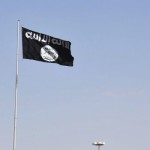 As the militias of the Islamic State of Iraq and Syria (ISIS) are inundating northwestern Iraq, ravaging the country and massacring the civilians, speculations pop up as to who might be behind this mess in Iraq. On the face of it, as the ISIS is basically a loosely formed Sunni coalition, the most appropriate candidate that comes to mind is Saudi Arabia, the self-proclaimed patron of all the Sunni movements in the Middle East that also has geopolitical designs on the region.
As the militias of the Islamic State of Iraq and Syria (ISIS) are inundating northwestern Iraq, ravaging the country and massacring the civilians, speculations pop up as to who might be behind this mess in Iraq. On the face of it, as the ISIS is basically a loosely formed Sunni coalition, the most appropriate candidate that comes to mind is Saudi Arabia, the self-proclaimed patron of all the Sunni movements in the Middle East that also has geopolitical designs on the region.
However, what if what is going on in Iraq now has actually been formulated and engineered in order to look like that? In other words, what if it is a carefully constructed ruse? If one looks more closely, one can pick up a number of significant clues that cast the situation in a different light.
Since the invasion of Iraq by the coalition forces in 2003, Iraq had been the mandate of a multi-national contingent led by the U.S. However, as control began to slip away from this multi-national contingent, and later U.S. troops also started to pull out of Iraq, the Quds Force, which is the special-ops unit of the Islamic Revolutionary Guards Corps (IRGC) of Iran, under the leadership of the enigmatic Major General Qasem Soleimani, by taking advantage of the situation managed to replace the multi-national force.
Dozens of comprehensive reports published in the past couple of years show that Soleimani has been wielding considerable power in Iraq and been enjoying a privileged position behind the political scene in that country. As it seems, he has under his thumb both Nouri al-Maliki, the Prime Minister of Iraq, and Masoud Barzani, the President of the Iraqi Kurdistan Region. By exploiting his immense clout in Iraq, he has been tirelessly setting up numerous Shi’ite militia bands and training and equipping them, not only to enhance his influence and maintain his empire in Iraq but also to keep the road to Syria, where many pro-Islamic Republic contingents fight for the Assad regime, secure.
However, it is possible that Soleimani also contributed to the forming of and having a hand in controlling the ISIS, albeit via indirect means and methods. In fact, not two weeks ago, Abdul Halim Khaddam, the former vice-president of Syria, told Asharq Al-Awsat that “Iran brought ISIS to Syria. No one has any doubts about that, and I know what I am saying. Iran is a main part of the fighting in Syria. There are the Shi’ite organizations, the Iranian Revolutionary Guards and Hezbollah, fighting alongside Assad. The fall of Assad will [be] a painful blow to the Iranian regime. If Assad’s regime falls, Iran’s presence in Iraq will be over and Hezbollah’s role in Lebanon will weaken, or shall we say, vanish.”
At first glance, this might look untenable as the ISIS is a Sunni extremist group which makes it ideologically averse to the Shi’ite extremist Islamic Republic. Past this, why would an Islamic Republic that already has Iraq in its tight grip want to destabilize Iraq? In order to answer that question, one must look back at the history of the Islamic Republic, especially at its foreign policy.
As I have explained in an article before, it is the nature of the Islamic Republic to have a tendency towards crisis creation and crisis management. It feeds upon crisis and exploits it to advance its agenda. The more than three decades of the history of the Islamic Republic is dotted with blatant instances of using that method to gain leverage in the international arena. The Iran Hostage Crisis in 1979, the Beirut Barracks Bombings in 1983, and the notorious nuclear program that is still going on are only a handful of those instances.
Now, imagine a crisis-friendly Islamic Republic that has so far gained if not everything but many things it has wanted from the international community through use of sheer force and extortion. Today this Islamic Republic is likely to need the ISIS for a number of reasons. One seems to be putting pressure on the West. It should not be taken for nothing that the hitherto dormant ISIS all of a sudden becomes active while the Islamic Republic is caught in the middle of rigorous negotiations over its nuclear program with the West. This crisis can loosen the West’s strictures on the Islamic Republic, i.e. the guardian of Iraq, as it might be thought to help contain the situation in Iraq.
In addition, the crisis in Iraq can instill fear in the hard-pressed Iranian people so that they won’t be willing to do anything in the way of opposing or toppling the regime. By putting the horrors of sectarian war before the people’s eyes, the regime can convince them that the Islamic Republic is their only protector in the face of this fierce Sunni insurgency. In this situation, playing on the Iranians’ sense of patriotism can bolster the regime’s position. As the Islamic Republic is mobilizing its troops in the west of Iran, the regime’s propaganda machine has already begun to capitalize on that patriotic message throughout the social media.
However, if one still finds it difficult to entertain the possibility that the Islamic Republic could be behind the ISIS, a simple lesson in geopolitics would do. It has been reported that the ISIS militias have demonstrated significant firepower and have even been using choppers, which shows that they are well-equipped. Had this happened in any southern provinces of Iraq like Anbar, which is, close to the border with Saudi Arabia, the regional power usually presumed to be behind the ISIS, the claim that Saudi Arabia is involved would have been tenable.
However, the area recently overrun by the ISIS, encompassing parts of Ninawa and Salahaddin provinces, lies to the other extreme of Iraq, far away from Saudi Arabia. In fact, it is enclosed between the road to Syria to the south – which is completely controlled by the Quds Force, cutting off the area under insurgency from Saudi Arabia, the Turkish border to the north, and the Syrian border to the west. Now, a crisis-ridden Turkey is not in a position to want to mess with the Islamic Republic. President Rouhani’s trip to Ankara that was much coveted by an almost bankrupt government in Turkey makes that clear. On the other hand, the eastern regions of Syria are under the influence of the Kurds who are not amenable to the ISIS.
As such, the only reasonable way to explain the newly-found might of the ISIS is that it was Soleimani who equipped them or at least facilitated their access to heavy arms and mechanized weapons. Coincidentally, drawing upon a report by an IRGC-affiliated website, Al-Arabiya has reported that Soleimani has been sighted in Iraq. As the report indicates, he seems to have been there before the insurgency flared up and is still there. Therefore, as things might not be what they seem to be at first glance, one will be well-advised to judge carefully or to postpone judgment until all becomes clear.



[…] http://eutopiainstitute.org/2014/06/could-the-quds-force-be-behind-the-isis-in-iraq/ […]